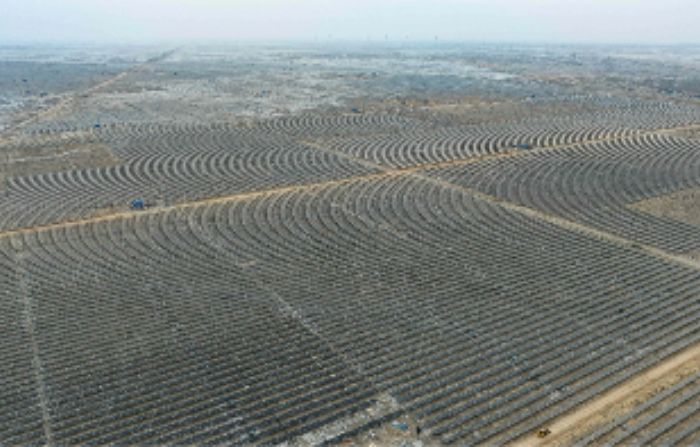- Monday, April 29, 2024
The area with second best solar radiation in the country after Ladakh and wind speeds five times of plains, served as an idle location for a renewable energy park.

By: Shubham Ghosh
A NARROW airstrip that doesn’t even have an air traffic controller to guide incoming airplanes and whose only infrastructure is a portable toilet and a make-shift office in a container in the midst of miles of barren land bordering Pakistan is an unlikely gateway to the world’s largest renewable energy park.
The airstrip was even smaller in December 2022, when Adani group head Gautam Adani, who was then the second richest person in the world, first used a small aircraft to reach the barren area that didn’t even have a pincode and got its name from a village 80-kilometers away.
The land hardly had any vegetation due to its highly saline soil, leave alone any habitation. But the area with second best solar radiation in the country after Ladakh and wind speeds five times of plains, served as an idle location for a renewable energy park.
Read: Reliance, Brookfield ink MoU to make renewable energy equipment in Australia
An 18-km drive from the airstrip through dusty arid land is the site for his group’s Khavda renewable energy park spread over 538 square kilometers – roughly five times the size of Paris.
When Adani first landed at Khavda, he joked if anyone could even find a mosquito in the area, his executives said.
But since then, his group has not just laid solar panels that will convert sun rays into electricity and wind mills to harness wind blowing at the speed of 8 meters per second, but also built colonies for workers, put up desalination plants to make saline water pumped out of 700 meters below ground portable and utilities such as mobile phone repair shops.
Read: India to install 250 GW of new renewable capacity by 2028
Adani Green Energy Ltd, India’s largest renewable energy company, will invest about Rs 1.5 lakh crore (£14.3 billion) to generate 30 megawatts of clean electricity at Khavda in Gujarat’s Kutch, it’s managing director Vneet Jaain said.
“We have just now commissioned 2,000 MW (2 GW) of capacity at Khavda and plan to add 4 GW in the current fiscal (financial year ending March 2025) and 5 GW every year thereafter,” he said.
The airstrip is used to ferry group executives from Mundra or Ahmedabad a few times a week.
Air traffic controller or ATC at Bhuj, some 160-km away, is the last guide post for airplanes going to Khavda. But it’s reach is only till ‘Tent City’ and pilots are virtually on their own for the last leg of 80-km or so including landing.
“We use visual aids and airplanes’ navigation systems to land. When taking off, we convey to Bhuj about the plans over phone,” a pilot flying the Adani Group-owned plane said.
The outer flange of the energy park is just one km from the international border with Pakistan. The one-km buffer is manned by BSF.
Executives said the airstrip was built in just 35 days in an area where even tractors had to be modified so they could operate in land that doesn’t easily absorb water.
The area has its own set of challenges – heavy dust storms during March to June, no communication and transport infrastructure, nearest habitable area being 80-km away, water not seeping under soil during rainy season, even ground water being saline and it being a restricted zone.
Executives said while some workers from Khavda village, accommodation are being built to house 8,000 workers.
Adani group’s renewable energy plans are the most ambitious by any corporate in the country which is targeting to generate 500 GW of electricity from non-fossil sources by 2030, as part of a broader plan of achieving net-zero emissions by 2070.
Khavda at its peak will generate 81 billion units that can power entire nations such as Belgium, Chile and Switzerland, they said.
Jaain said the 30 GW planned at Khavda would comprise 26 GW of solar and 4 GW of wind capacity.
AGEL’s existing operational portfolio comprises 7,393 MW solar, 1,401 MW wind and 2,140 MW wind-solar hybrid capacity.
While Khavda region witnesses 2,060 kWh/m2 of high solar irradiation and one of the best wind resources in India, with speeds of 8 meters per second, frequent sandstorms necessitate cleaning of solar panels several times in a day.
Project will be entirely covered with waterless robotic module cleaning systems, executives said. Khavda land belongs to the government, which leased out the site to Adani group for 40 years.
Executives said over the last five years, Adani Green conducted geotechnical investigations, seismic studies, a centrifuge study by Cambridge, resource assessment and land studies, Environment and Social Impact Assessment (ESIA), Environmental and Social Due Diligence (ESDD), and a detailed feasibility study, amongst several others, before embarking on the development of the site.
The construction started in 2022. The comprehensive infrastructure development effort included the construction of 100 km roads, 50 km of drainage, establishment of desalination and 3 reverse osmosis (RO) plants with a total capacity of 70 cubic meter per hour to meet the drinking water requirements of the project staff, laying optical fiber cables for 180 km for connectivity, and concrete batching plants.
(PTI)
![]()